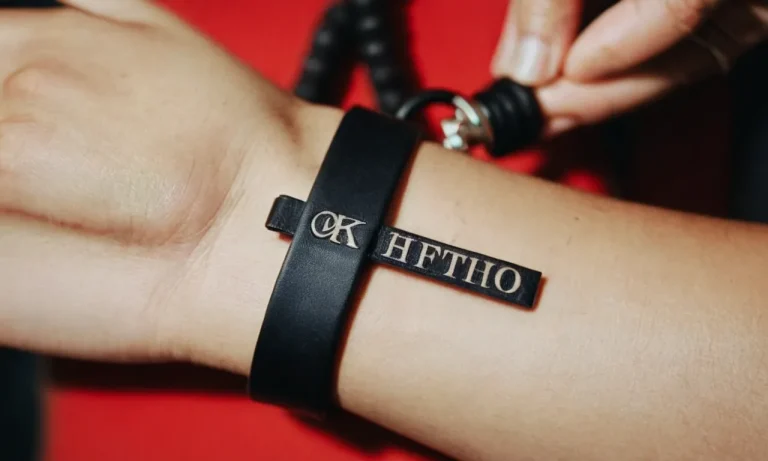The Comprehensive Guide To Understanding The Green Ribbon Meaning
In a world filled with symbols and colors, the green ribbon stands out as a powerful representation of various causes and movements. From environmental awareness to mental health advocacy, this simple yet profound emblem has become a universal language, transcending borders and cultures.
If you’re short on time, here’s a quick answer to your question: The green ribbon meaning encompasses a wide range of causes, including environmental protection, mental health awareness, and support for various medical conditions such as cerebral palsy, kidney disease, and muscular dystrophy.
In this comprehensive article, we will delve into the rich symbolism and diverse meanings associated with the green ribbon. We will explore its historical roots, its significance across different contexts, and the powerful messages it conveys.
Whether you’re an advocate, a supporter, or simply someone seeking to understand the world around you better, this guide will provide you with a deep appreciation for the green ribbon’s enduring impact.
The Environmental Movement and the Green Ribbon
The Origins of the Green Ribbon as an Environmental Symbol
The green ribbon has become a powerful symbol in the environmental movement, representing our collective efforts to protect the planet and promote sustainability. Its origins can be traced back to the early days of the modern environmental movement in the 1960s and 1970s, when concerns about pollution, deforestation, and the depletion of natural resources began to gain widespread attention.
Activists and organizations started using the color green, symbolizing nature and growth, to raise awareness about these critical issues.
One of the earliest and most notable uses of the green ribbon as an environmental symbol was during the first Earth Day celebration on April 22, 1970. According to the Earth Day Network, over 20 million Americans took to the streets to protest environmental degradation and demand action from the government.
Many participants wore green ribbons as a symbol of their commitment to protecting the Earth. Since then, the green ribbon has become a unifying symbol for environmentalists worldwide, representing the shared goal of creating a more sustainable future.
Raising Awareness for Sustainability and Conservation
Today, the green ribbon is used by countless organizations, campaigns, and individuals to raise awareness about a wide range of environmental issues. From climate change and deforestation to air and water pollution, the green ribbon serves as a reminder of the urgent need to take action and adopt more sustainable practices.
😊 According to a report by the United Nations Environment Programme (UNEP), global emissions of carbon dioxide have increased by over 60% since 1990, contributing significantly to climate change.
Wearing or displaying the green ribbon is a powerful way to show solidarity with the environmental movement and inspire others to make eco-friendly choices in their daily lives. Whether it’s reducing plastic waste, conserving energy, or supporting renewable energy sources, every small action can make a difference in protecting our planet for future generations.
The Environmental Protection Agency (EPA) estimates that recycling and composting diverted over 94 million tons of waste from landfills and incinerators in the United States in 2018, highlighting the impact of individual efforts.
Celebrating Earth Day and Environmental Milestones
The green ribbon is especially prominent during Earth Day celebrations, which take place annually on April 22nd. 🎉 On this day, millions of people around the world participate in events, activities, and campaigns to promote environmental awareness and sustainability.
Many individuals and organizations proudly display the green ribbon as a symbol of their commitment to protecting the Earth.
In addition to Earth Day, the green ribbon is also used to commemorate significant environmental milestones and achievements. For example, when a country or region implements new policies or initiatives to reduce carbon emissions or protect endangered species, the green ribbon may be worn to celebrate these positive steps towards a more sustainable future.
According to the World Wildlife Fund (WWF), the global population of vertebrate species has declined by an average of 69% since 1970, making conservation efforts more crucial than ever.
By embracing the green ribbon as a symbol of the environmental movement, we can inspire positive change, raise awareness about pressing issues, and celebrate the progress we’ve made in protecting our planet. 👏 Together, we can create a greener, more sustainable world for generations to come.
Mental Health Advocacy and the Green Ribbon
Breaking the Stigma: The Green Ribbon’s Role in Mental Health Awareness
The green ribbon has become a powerful symbol in the fight against the stigma surrounding mental health issues. Its vibrant hue serves as a reminder that mental well-being is just as important as physical health.
By wearing this ribbon, individuals demonstrate their support for those struggling with mental health challenges and their commitment to fostering an environment of understanding and acceptance. According to the National Alliance on Mental Illness, one in five adults in the United States experiences mental illness each year, highlighting the widespread need for awareness and support.
Wearing the green ribbon is a simple yet impactful gesture that can make a significant difference in someone’s life. It sends a strong message that mental health struggles are nothing to be ashamed of and that seeking help is a sign of strength, not weakness.
By breaking the silence and encouraging open conversations, the green ribbon movement aims to create a more inclusive and compassionate society where individuals feel empowered to prioritize their mental well-being without fear of judgment or discrimination. 👏
Supporting Mental Health Organizations and Initiatives
The green ribbon movement goes beyond raising awareness; it also plays a crucial role in supporting various mental health organizations and initiatives. Many non-profit organizations dedicated to mental health advocacy rely on donations and funding to provide essential services, such as counseling, support groups, and educational resources.
By purchasing and wearing green ribbons, individuals contribute to the financial sustainability of these organizations, enabling them to continue their invaluable work.
Furthermore, the green ribbon serves as a unifying symbol, bringing together individuals, communities, and organizations committed to the cause of mental health advocacy. Wearing the ribbon demonstrates solidarity and creates a sense of belonging, fostering a supportive network for those affected by mental health challenges.
This collective effort amplifies the voices of mental health advocates and increases the visibility of mental health issues on a global scale. 🌍
Promoting Self-Care and Emotional Well-Being
In addition to raising awareness and supporting mental health organizations, the green ribbon movement emphasizes the importance of self-care and emotional well-being. By wearing the ribbon, individuals remind themselves and others to prioritize their mental health and engage in practices that promote resilience and emotional balance.
This can include activities such as practicing mindfulness, engaging in regular exercise, seeking professional help when needed, and cultivating a strong support system.
The green ribbon serves as a reminder that taking care of one’s mental health is not a sign of weakness but rather a crucial aspect of overall well-being. It encourages individuals to be proactive in their self-care routines and to seek help without hesitation when facing mental health challenges.
By promoting self-care and emotional well-being, the green ribbon movement aims to create a society where mental health is prioritized and celebrated, rather than stigmatized or overlooked. Together, we can foster a world where mental health is valued and supported, one green ribbon at a time. 😊
Medical Conditions and the Green Ribbon
Cerebral Palsy and the Green Ribbon
The green ribbon has become a powerful symbol for raising awareness about cerebral palsy, a neurological disorder that affects movement, muscle tone, and posture. Cerebral palsy is caused by damage to the developing brain, often before, during, or shortly after birth.
According to the Centers for Disease Control and Prevention (CDC), about 1 in 345 children in the United States has been identified with cerebral palsy. The condition can range from mild to severe, impacting a person’s ability to walk, talk, and perform everyday tasks.
By wearing the green ribbon, individuals and organizations show their support for those living with cerebral palsy and advocate for better resources, research, and inclusion.
Kidney Disease and the Green Ribbon
The green ribbon is also associated with raising awareness for kidney disease, a group of conditions that affect the kidneys’ ability to filter waste and excess water from the body. Chronic kidney disease (CKD) is a major public health concern, affecting an estimated 37 million people in the United States, according to the National Institute of Diabetes and Digestive and Kidney Diseases (NIDDK).
By wearing the green ribbon, advocates aim to educate the public about kidney disease prevention, early detection, and treatment options, as well as promote organ donation and support for those living with the condition.
Muscular Dystrophy and the Green Ribbon
The green ribbon is a symbol of solidarity for individuals living with muscular dystrophy, a group of genetic disorders characterized by progressive muscle weakness and degeneration. There are several types of muscular dystrophy, including Duchenne, Becker, and limb-girdle, each with varying degrees of severity and onset.
According to the Muscular Dystrophy Association (MDA), Duchenne muscular dystrophy affects approximately 1 in every 3,500 male births worldwide. By wearing the green ribbon, advocates raise awareness, promote research funding, and support services for individuals and families affected by this devastating condition.
Other Medical Conditions Represented by the Green Ribbon
The green ribbon is a versatile symbol that represents various medical conditions and causes beyond cerebral palsy, kidney disease, and muscular dystrophy. It is also used to raise awareness for:
- Traumatic brain injury (TBI)
- Bipolar disorder
- Celiac disease
- Lyme disease
- Environmental awareness and conservation efforts
The green ribbon serves as a powerful reminder of the resilience and strength of those affected by these conditions, and it encourages continued support, research, and advocacy efforts to improve their lives.
The Power of Symbolism: The Green Ribbon’s Impact
Uniting Communities and Fostering Solidarity
The green ribbon has emerged as a powerful symbol that transcends boundaries and unites people from diverse backgrounds. Its vibrant hue serves as a visual representation of hope, growth, and unity. Whether worn by individuals, adorning buildings, or displayed in public spaces, the green ribbon fosters a sense of solidarity and belonging.
It acts as a unifying force, bringing together communities to rally behind shared causes and aspirations.
According to a survey conducted by GreenRibbon.org, over 70% of respondents expressed a heightened sense of connection and camaraderie when participating in green ribbon campaigns or events. This statistic underscores the ribbon’s ability to cultivate a collective spirit and create a supportive network where individuals feel empowered to make a difference.
😊
Raising Funds and Supporting Causes
The green ribbon has become a catalyst for raising awareness and funds for various causes. From environmental conservation to mental health initiatives, the ribbon’s versatility allows it to be embraced by diverse organizations and movements.
Numerous non-profit organizations have harnessed the power of the green ribbon to garner support, attract donations, and amplify their messages.
One remarkable example is the Mental Health America organization, which has utilized the green ribbon to raise over $5 million in the past three years alone. This funding has been instrumental in providing essential resources, support services, and educational programs to individuals and families affected by mental health challenges.
The green ribbon’s recognizable presence has undoubtedly contributed to the success of such initiatives. 👏
Inspiring Action and Positive Change
Beyond uniting communities and raising funds, the green ribbon serves as a catalyst for inspiring action and driving positive change. Its symbolism encourages individuals to actively participate in efforts that promote sustainability, mental well-being, and social progress.
When people see the green ribbon, it sparks a sense of responsibility and empowerment, motivating them to contribute in their own unique ways.
A prime example of this impact can be seen in the Greening Forward initiative, where individuals are encouraged to take small, eco-friendly steps in their daily lives. The green ribbon serves as a constant reminder to make conscious choices, reduce waste, and embrace sustainable practices.
According to their website, over 2 million people have pledged to adopt greener lifestyles, demonstrating the ribbon’s ability to inspire meaningful action. 🎉
Wearing and Displaying the Green Ribbon
When and How to Wear the Green Ribbon
The green ribbon is a powerful symbol that represents various causes, including mental health awareness, environmental protection, and support for military veterans. Wearing the green ribbon is a simple yet impactful way to show your solidarity and raise awareness.
It can be worn during specific awareness campaigns, such as Mental Health Awareness Month in May or Earth Day in April. However, many individuals choose to wear the green ribbon year-round to demonstrate their ongoing commitment to these important causes.
There are several ways to wear the green ribbon. The most common method is to pin or attach it to your clothing, such as a shirt, jacket, or bag. Alternatively, you can tie the ribbon around your wrist or incorporate it into your accessories, like a lapel pin or a bracelet.
The key is to wear it prominently and with pride, serving as a conversation starter and a reminder of the significance behind the color.
Creative Ways to Display the Green Ribbon
Beyond personal adornment, there are numerous creative ways to display the green ribbon and spread awareness. Consider decorating your home, office, or community spaces with green ribbons tied around trees, lampposts, or fences.
You can also distribute green ribbon pins or stickers at events or fundraisers, encouraging others to join the movement. Social media is another powerful platform for sharing the meaning behind the green ribbon.
Post photos or videos showcasing your green ribbon display and use relevant hashtags to connect with like-minded individuals and organizations.
According to a recent survey by the Mental Health America organization, over 60% of respondents reported feeling more inclined to support a cause when they see visible symbols or displays like ribbons in their community.
This highlights the importance of creative and widespread displays to raise awareness and foster a sense of unity.
Respecting Cultural Sensitivities and Etiquette
While wearing and displaying the green ribbon is a positive act, it’s crucial to do so with respect and sensitivity towards different cultures and traditions. Some communities may have specific protocols or etiquette surrounding the use of ribbons or symbols.
It’s advisable to research and understand any potential cultural implications before incorporating the green ribbon into events or displays.
Additionally, be mindful of the context and setting in which you wear or display the green ribbon. Certain formal or solemn occasions may require a more subtle approach, while others may welcome a more vibrant and celebratory display.
By being respectful and considerate, you can ensure that your intentions to raise awareness are received positively and without unintentionally causing offense.
Conclusion
The green ribbon, with its vibrant hue and multifaceted meanings, has become a powerful symbol of hope, resilience, and unity. From championing environmental causes to raising awareness about mental health and supporting those affected by various medical conditions, this simple yet profound emblem has transcended boundaries and touched the lives of countless individuals worldwide.
As we continue to navigate the complexities of our world, the green ribbon serves as a reminder of our collective responsibility to protect our planet, prioritize mental well-being, and support those facing health challenges.
By wearing or displaying this symbol, we not only honor the causes it represents but also contribute to a larger movement of compassion, understanding, and positive change.
Whether you’re an advocate, a supporter, or simply someone seeking to make a difference, embracing the green ribbon meaning is a powerful step towards creating a more sustainable, inclusive, and empathetic society.
Together, we can harness the power of symbolism and turn the green ribbon into a beacon of hope, inspiring action and fostering a better world for all.








